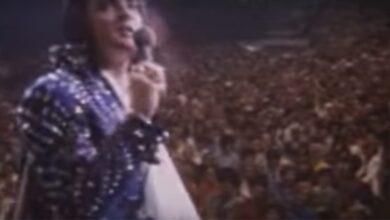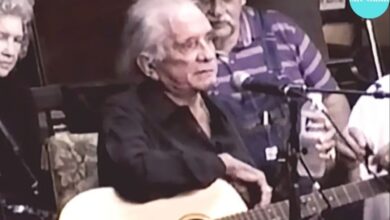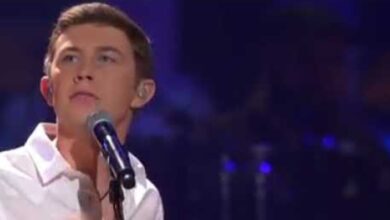This Popular Dance From The 1950s, Do You Still Remember It Today
The emergence of “The Stroll” not only highlighted the evolving music scene but also served as a reflection of the social transformations taking place in America during the late 1950s. This was a time when rock ‘n’ roll was beginning to assert itself as a dominant genre, breaking away from the traditional forms of music that previously occupied the airwaves. The spirit of rebellion and youthful exuberance embodied in the dance was a direct response to the conservative norms of the previous generations, as teenagers sought ways to assert their independence and carve out their own identity in a shifting cultural landscape.
The dance was simplistic in its execution, an attribute that contributed significantly to its widespread appeal. It allowed for anyone, regardless of dancing ability, to participate and enjoy themselves on the floor. This inclusivity reinforced the communal atmosphere often found in teen gatherings, sock hops, and other social functions. As participants formed two lines, a sense of connection was created, not just between couples but among all those involved. Each individual was not just a dancer but a performer, contributing to the spirit of celebration that characterized the era.
Moreover, “The Stroll” was more than a pastime; it represented a new form of social interaction among adolescents. It provided a venue for young people to meet and connect, offering a safe space to flirt, socialize, and enjoy one another’s company. The dance allowed couples to take turns showing off their unique styles, showcasing their personalities through their movements and choice of attire. This newfound freedom in socialization mirrored the gradual changes in norms surrounding dating and relationships during the time, as young people began to break away from the traditional courtship practices of earlier decades.
The popularity of “The Stroll” was also amplified by the rise of television as a cultural medium. Shows like “American Bandstand” catalyzed the dance’s dissemination, featuring not just musical performances but also the dances that had captured the hearts of America’s youth. Dick Clark, as the host, played a pivotal role in shaping pop culture, often spotlighting emerging trends and facilitating a sense of national unity through shared cultural experiences. Teenagers across the country would watch in envy and excitement as they saw their peers dance on screen, sparking a desire to participate in the same joyous activities.
At the same time, the global landscape was shifting. The Civil Rights Movement was gaining momentum, and music became an important vehicle for change. “The Stroll,” emerging from African American communities, broke down racial barriers in a time of segregation by allowing people of all backgrounds to come together on the dance floor. The dance was a unifying force at a time when cultural divisions ran deep, illustrating how music and dance could transcend societal limitations and foster a sense of community among diverse groups.
In the larger context, The Diamonds and their hit song also exemplified the ways in which Canadian artists contributed to the American music scene during this time. Their harmonious style and catchy melodies resonated deeply with audiences, helping to promote the doo-wop genre that was becoming increasingly popular. The success of “The Stroll” not only bolstered their career but also highlighted the fluidity of cultural exchange between the United States and Canada during this era. This synergy between neighboring countries enriched the musical tapestry of both, showcasing how music has the power to connect and influence across borders.
While “The Stroll” was a dance defined by its lighthearted nature, it also reflected the underlying currents of change occurring during the 1950s. Teenagers were at the forefront of these transformations, asserting their autonomy and engaging in a cultural dialogue that would continue to evolve in the following decades. The dance itself became a rite of passage for many, a fond memory of carefree nights spent in gymnasiums under dimmed lights, with laughter and music echoing off the walls. The influences of “The Stroll” would later echo into the 1960s and beyond, as youth culture continued to push boundaries and redefine societal expectations.
In subsequent years, the nostalgia surrounding “The Stroll” would inspire its resurgence in various forms of media and popular culture, from retro-themed parties to television shows celebrating the music and dances of the past. The dance remains a nostalgic symbol of an era when rock ‘n’ roll took center stage, encapsulating the essence of youthful revelry and the simplicity of shared experiences. Even as music styles evolved and new trends emerged, the spirit of “The Stroll” endures, a testament to the lasting impact of rock ‘n’ roll on American culture.
Artists who emerged following this period, including those who would later dive into the rock and pop genres, often drew inspiration from the rhythms and styles that characterized the music of the 1950s. The legacy of groups like The Diamonds, and their lively contributions to pop music, are evident in the works of countless musicians who have tried to capture that same sense of joy and camaraderie in their performances. Thus, “The Stroll” and its accompanying melody occupy a cherished place in the annals of music history, representing not just a dance, but a cultural milestone that signified a shift toward greater freedom, expression, and social connection among America’s youth.
?si=CbHsPwTM-VodZAIG





